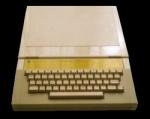There are quite obviously a whole bunch of telecommunications equipment officiandoes out there in cyberspace as we recently received yet more information on the BT 2105 Merlin Messaging Terminal (EUG #65) from none other than John Davies, who designed the on-screen menus for it. In fact, this makes this particular expansion the item we have had most response to via internet since the EUG mag went on-line back in 2002. Mr. Davies is also particularly knowledgable about the unit itself as he was employed with BT from right after its inception in 1982 until early 1991, which is, co-incidentally almost the entire shelf-life of the Acorn Electron.
"When I left BT Technical College," John recalls. "I moved to BT Merlin's offices in Felixstowe. At the time, the M2105 was in its design stages. I wasn't involved early on but, as I recall, the expansion unit contained a 1,200 bps modem, some extra ROM for the code and the CMOS RAM for storing logs, and the CMOS backup battery. Not a lot for such a big box. The one thing I do remember is that early boxes had a hand-wired ground to one of the modem pins to turn on the equaliser. The software company hadn't realised it was necessary and we wired it on until they altered the code to turn it on via machine code."
At the same time, systems analysis was being carried out on Interflora's business model in the hope of eliminating some of the telephone calls. British Telecom used to charge a long distance telephone call at peak rate in units of twelve seconds. What used to happen pre-Merlin was that when, say, the London branch got a call for a recipient in Manchester, the florist in London would call the florist in Manchester. After a while they would get to know each other quite well and so there would be quite a lot of 'small talk' before the order was actually passed on. In fact, I believe it was discovered that the average message between branches took three and a half minutes to pass on, with two and a half minutes of this being 'small talk' between staff."
Originally the M2105 was tasked with delivering an order between branches in a single call unit, slashing the cost of an average call cost by nearly 200 per cent. But in practice the trials proved this was to be impossible. "One of my unenviable jobs in the Interflora project was to count the average number of characters which were contained in a message to a recipient," says John. "I had to count up all the characters in exactly 1,000 messages which lovestricken couples had had attached to their flowers - including punctuation. Funny, but I still remember the answer was 72. The average message, when combined with the 'to' address and 'from' address just over twelve seconds to send." However, just as we were preparing to announce that passing a message would probably cost two units, not one, BT announced an increase in time per unit, jumping from 12 to 15 seconds. Says John, "90% of the messages could then get through in that time and Interflora were very happy with the proposal."
The project also led to vast swathes of data-entry clerks joining the dole queue, as pre-Merlin, every Interflora shop periodically sent its dockets to Interflora by post where a whole room of full-time staff did nothing but key into a mainframe from, to, product and value from every docket from every florist. When the Interflora Merlin was launched, a process which went "remarkably well, with not even a hiccup at the start", the docket information was sent directly to Interflora's ICL accounting mainframe and the staff were immediately surplus to requirements.
The BT Merlin we featured brings a tear to John's eye. "If my menu comes on, it's a sign that the EPROM is still fully working and the unit is theoretically capable of sending and receiving data for delivering Interflora's flowers. Originally there was a status line system. My menu was a great improvement. However, if the menu doesn't appear then you're on your own. I don't know enough about the Acorn and I never remember seeing a circuit diagram. The communication was basically from modem-to-modem and the average message could be sent in one frame. Unlike nowadays, there was no fancy modem 'training' at the start of a call and to keep within the fifteen seconds, as soon as the modem detected a stable tone it started to send."
And what of the other project, the one that we hear so little about when it isn't being puffed up by Electron User articles? "You mean the M2105 Healthnet," quips John. "Originally conceived for a London hospital. There was a software company writing some code with the same architecture and the original idea was that two Merlins together could communicate information to different departments. That is, if a patient was being discharged, a nurse would type a suitable message to either the ambulance department or pharmacy or anyone who needed to know. But the user interface I saw on it was pretty awful. Just a set of abbreviations in the status bar and you really needed some good training to be able to use it. If I was put off, then I'd imagine most people stared blankly at it... then used the telephone instead."
Alas, as with all of our contributors to this particular subject so far, John couldn't lay his hands on any official documentation or user guide [This has now been found! - Ed]. One day we will, of course, track them down, perhaps in time for EUG #70 after we've heard from some more of you...?


 1st January 2009
1st January 2009
